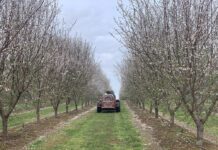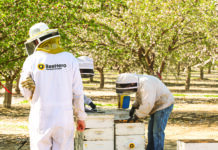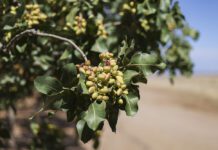
Despite the long list of challenges currently being faced by the California tree nut industry, leaders speaking at the California Tree Nut Conference highlighted some bright spots for growers.
Research into health benefits from tree nut consumption, technological advances in production and processing, and the economic impact tree nut production has on the state are all positives for the industry, they agreed.
Water availability, increasing regulation and back log of inventory caused by shipping difficulties and supply/demand imbalances were some of the challenges listed.
Roundtable participants Richard Waycott, CEO of Almond Board of California; Richard Matoian, president of American Pistachio Growers; and Robert Verloop, executive director and CEO of California Walnut Board and Commission answered a series of questions about their commodities and their direction in the future from West Coast Nut publisher Jason Scott.
Nutrition research is one of the ways all three tree nut industries can work together to achieve market growth. Each of the tree nuts is a unique commodity, Matoian pointed out, but they supply similar consumer wants. The Nutrition Research Education Foundation is funded by all three tree nut industries to prove health and nutrition benefits from consumption of almonds, pistachios and walnuts. Each commodity does individual research, Matoian said, but the Foundation is one way they work together.
Waycott noted that all three nut crops have a stake in improving movement of nuts for export and that they were all working on the Ocean Shipping Reform Act and were present for a meeting at the Oakland Port to show their support, one of the few voices there for agriculture, he added. All three commodity leaders were also working to negotiate better foreign market access.
From a political standpoint, the export value of the three nut crops should be recognized, Verloop said. Impediments to export in the ports are having a negative effect on these commodities and impacting workers and communities.
“We are a $75-billion-a-year export product and we need to act like it,” Verloop said. “Ag as a whole needs to do that.”
Waycott stressed that water availability is the main issue for tree nut growers. Added to the list are higher production costs and the logistical nightmare of shipping product. Trade policies to put almonds on the same level with other commodities and access to credit at reasonable terms are needed, he said.
Verloop took aim at domestic marketing. Walnuts, he said, are being promoted as a healthy food, but in stores, they are found on the baking aisle; not the healthiest type of products nor does it represent adequate volume. Placing walnuts where consumers will find them, such as in the produce aisle, and ensuring quality will move them, he added.
Increasing government regulations are presenting challenges to tree nut growers, Matoian said. Making lawmakers aware of the impact of those regulations is important. Discussion of crop protection tools also needs to happen, Waycott said. The tree nut industries need to work with Foreign Agriculture Service and Animal Plant Health Inspection Service (APHIS) to set reasonable standards.
Waycott said EU’s “Green Deal” has the potential to limit the use of crop protection tools. In addition, he said many of the retaliatory tariffs remain in place, limiting market access.
Even with some exemptions, U.S. tree nuts are at a disadvantage with countries like Australia, which has negotiated much lower tariffs on its tree nuts. The Almond Alliance is working in Washington D.C. on a more positive approach to trade, he added.
Restrictions on pesticide use and lack of products registered for use were Matoian’s concerns. He noted that MRL issues with the EU could further limit shipments.
Verloop pointed out that crop insurance, particularly this year with heat damage to the walnut crop, was an area that needed attention. There is currently no insurance coverage for heat damage and Matoian said that coverage for other types of damage was low. Establishing standards would be a start and recognizing climate caused crop damage is important, though he said any changes would likely take years.
Importance of ongoing tree nut production research by University of California was stressed by all three industry leaders. Verloop said looking more closely at how consumers define walnut quality would help growers deliver a better product. Studying all stages of cold chain management of product and how it affects quality would also help growers.
“Our crop quality is what separates us from the competition,” Verloop said.
In the production research realm, Matoian said a focus on alternatives to pesticides would help with the regulatory pressure growers now face when they need to protect their crop from insect and disease damage. Mating disruption technology for navel orangeworm control was a win for growers, he said.
Additional focus on research to increase productivity would also be welcome. Matoian said the use of micronutrients is now being embraced by tree nut growers following the lead of grape growers. Along the same line, orchard spacing, tree training and pruning are areas where growers can improve productivity and possibly save on labor costs.
Development of rootstocks that are resistant to disease could help with the loss of crop protection tools, Waycott said. Use of biologicals to combat insect pests and development of a pheromone trap for leaffooted bug are all advances in pest control technology that help growers maintain healthy orchards.
Growers could also use a new look at stocking rates for pollination. Waycott said studies may show they can be reduced and save pollination costs without affecting yields.
Adding value to hulls and shells is another area under development by the almond industry and researchers.
New technologies could help pistachio growers deal with the effects of warmer winters, Matoian said as synchronizing male and female trees at bloom is an increasing problem the industry must deal with. New products to help break dormancy will be important in the future, he added.
When it comes to processing, Matoian said robotics will likely be the next step, eliminating some hand sorting lines. The ability of robotic sorters to identify NOW is key to use, but Matoian said sorting out aflatoxin-infested nuts still presents a problem for identifying NOW damage.
Boosting demand for tree nut products means overcoming the current logistics issues that are challenging exports. Here again, Waycott said, is where new technologies are helping with creation of new products using byproducts. The biomass from almond orchards, health products from almond oil and energy bars made from hulls are examples. Verloop said expanding the definition of products that can be delivered with food assistance programs would help move more walnuts into domestic markets.
New flavors and pasteurization techniques will help with improving shelf life of products, he said. The Food and Drug Administration’s new definition of healthy foods can trigger use of nuts in USDA programs.
Prices for this year’s crop will certainly have an impact, the industry leaders agreed. Verloop said there is so much product in the line now, and with the higher dollar reducing buying power in export markets, it will take a year or two to work through.
“There is a lot more product than what the market is demanding right now,” he said. In the future, Verloop noted, SGMA’s impacts as well as tree removal programs could reduce supply.











